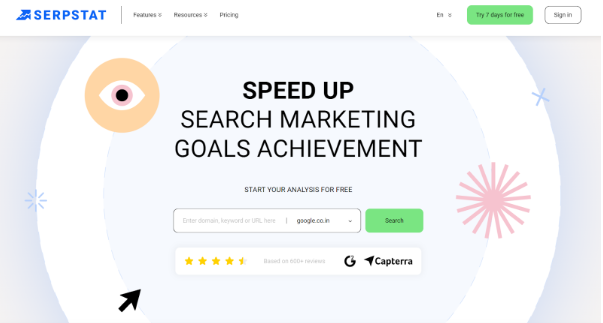TechRadar Verdict
For the price, Serpstat does almost everything right. In particular, keyword rank analysis is presented in an actionable way and the user interface is seamless.
Pros
- +
SEO and PPC campaign research with integrated functionalities.
- +
Effective Competitor Analysis
- +
User-Friendly Interface
- +
Easy-to-understand reports
- +
Provides detailed keyword value assessment
Cons
- -
Certain sites may not be fully crawled
- -
Outdated tutorials
- -
Occasional bugs
Why you can trust TechRadar
Serpstat is an all-around SEO tool that can meet various digital marketing requirements. Whether you're in charge of an online store, handling PPC campaigns, or leading marketing efforts, Serpstat's cloud-based platform provides strong features to improve your online presence. You can do extensive Keyword research, site audit, competitor analysis, keyword clustering, and even AI content generation all with Serpstat. In this review, we will take a close look at this popular SEO tool. We will also cover its pricing plans, free and paid products, and monitor their usefulness, all in detail. So, let’s get started.
- We've featured the best onpage SEO tools.
Serpstat: Plans and pricing
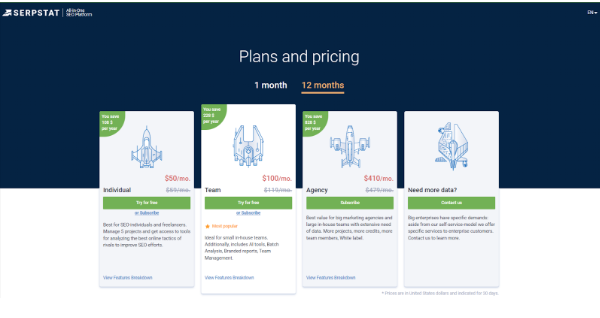
Individual Plan
Priced at $50/month (or $59 if billed monthly), this plan is ideal for individuals and freelancers. It lets you manage 5 projects and provides access to various tools for analyzing your competitors and doing your keyword research. The plan includes 100 daily searches, 2,000 results per report for website and backlink analysis, and 50,000 export rows per month.
Team Plan
This plan is the most popular choice for small in-house teams and comes for $100/month (or $119 if billed monthly). It includes AI tools, Batch Analysis, Branded reports, Team Management, and more. The Team Plan offers 500 daily searches, 10,000 results per report for website and backlink analysis, and 250,000 export rows per month.
Agency Plan
For $410/month (or $479 if billed monthly), this plan offers the best value for big marketing agencies and large in-house teams with extensive data needs. It includes more projects, credits, team members, and even different white-label features. This plan offers up to 5,000 daily searches, 100,000 results per report for website analysis, 10,000 results for backlink analysis, and 2.5 million export rows per month.
Sign up to the TechRadar Pro newsletter to get all the top news, opinion, features and guidance your business needs to succeed!
All the plans coming from Serpstat include access to 230 Google search regions and various levels of API access, with the Agency Plan offering the most comprehensive features. Not to mention, the annual subscriptions come with significant discounts and can save you up to $828 per year depending on the plan.
Serpstat: Features
Keyword Research
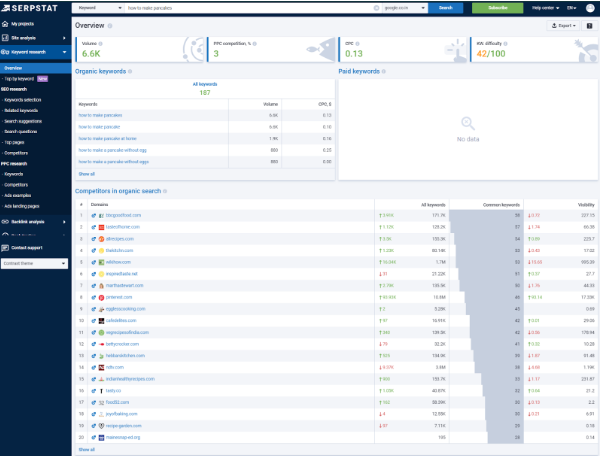
Serpstat's Keyword Research tool is really helpful for finding and analyzing keywords that can improve your website's organic traffic. This tool accesses a vast database of over seven billion keywords and 4.54 billion suggestions. Plus, it makes keyword analysis easier as you can quickly evaluate hundreds of keywords in a single click. During this, it provides important metrics like monthly search volume, keyword difficulty, and other relevant data to help you make informed decisions about which keywords to target. You can also gather and analyze your competitors' most successful keywords. This thing, in particular, helps you compete better in your niche market.
Another useful feature of Serpstat is its Keyword Niche Finder which thoroughly explores your niche. It helps you discover related keywords and search terms that are frequently used alongside your primary keywords. This feature is invaluable for understanding your audience's search behavior and tailoring your content accordingly. Furthermore, Serpstat also provides insights for your competition for any topic in both paid and organic search. With the option to try Keyword Research and 50 different marketing tools, it offers a comprehensive platform to improve your website's visibility and traffic.
Keywords Clustering
The Serpstat Keywords Clustering feature groups up to 50,000 keywords based on their similarity in Search Engine Results Pages (SERPs) to enhance your SEO strategy. This automatic grouping optimizes your website's content structure and helps boost its rankings.
For this, add keywords to the clustering project by pasting them directly or importing them in CSV or TXT files. Serpstat efficiently handles these keywords and excludes invalid entries like the ones with only symbols or numbers. Apart from this, you also have customization options, including setting parameters for search engines, countries, and specific regions or cities for local keyword grouping. Once done, choose the connection strength for the thematic grouping of keywords, with medium strength ideal for most projects. Moreover, the “Type of Cluster” setting groups keywords by matching URLs in the top 30 search results. It provides detailed and relevant grouping.
After the clustering process, you receive a list of keyword clusters with details like keyword volume and connection strength. You can manually add, delete, or move keywords to different clusters to align with your SEO goals. Likewise, the export feature lets you integrate keyword clusters into your website's pages or use them for further analysis.
Content Analysis
Serpstat’s Content Analysis is designed to transform content creation and optimization. It is beneficial for various professionals, such as writers, content marketers, editors, SMM managers, PR specialists, and SEO or PPC specialists. Whether you work in a marketing agency or own a business, these tools can significantly improve your content strategy.
The Article Builder is a key feature that helps create articles step by step. You can edit each paragraph's title, structure, and text and make manual changes as required. It generates articles based on your inputs, including necessary keywords, to align with your SEO goals. Similarly, its Text Editor and Paraphrasing tool are essential for refining content to ensure uniqueness and engagement. Likewise, the Keywords Extraction feature identifies important keywords to improve their relevance and searchability.
During our research, we found Serpstat’s AI Detection tool quite quick and helpful. Along with that, you also get YouTube Transcription, Plagiarism Detection, Description Generation, and Title Generation, covering all aspects of content creation and optimization within Serpstat. These features save time and guarantee high-quality, unique content tailored to your audience's needs.
Competitor Analysis
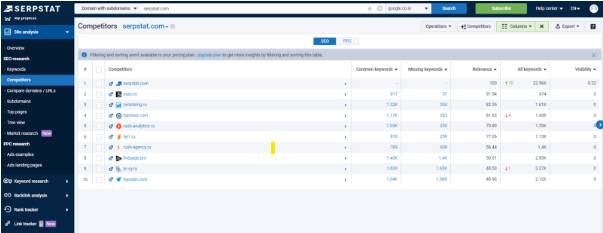
Serpstat's Competitor Analysis tool provides in-depth insights into your competitors' websites and lets you analyze their SEO and PPC strategies. This in-depth view helps you understand your rival's tactics and performance. Moreover, you can research your competition for any topic, ad, or keyword, helping you gain a thorough understanding of the market's competition. You can even find out your competitor’s successful backlinks, further giving you a better strategy for your own site.
By using Serpstat's competitor analysis, you can discover new ideas and strategies to improve your website's rankings. It provides detailed domain comparisons to identify ranking gaps and growth opportunities. Plus, you can also track your competitors' growth dynamics and find solutions for your SEO strategy.
Additionally, the tool offers an analysis of top organic competitors by keyword. This lets you compare metrics such as domain rank, visibility, number of organic keywords, backlinks, and external links on a single page. This feature is particularly useful for identifying areas where your competitors are ranking and where you need to focus your efforts.
Site Audit
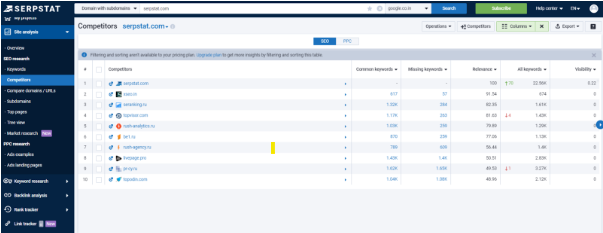
The Site Audit feature helps you identify and fix on-site SEO errors to boost your website's rankings on Google and other search engines. Serpstat's Website Audit gives a thorough breakdown of all the problems discovered during the audit and simple steps to resolve them. Plus, we love how the results are showcased in super-intuitive graphs.
Customization is key with this tool as it lets you tailor the audit settings to your specific needs. The audit categorizes issues into a high, medium, or low priority to focus on the most critical problems first. You even get a Domain Optimization Score that estimates your site's overall optimization level. Also, if you want to run this frequently, users can schedule the audit to run weekly, daily, or manually as you want it. With this, Serpstat will automatically crawl your website and notify you when the audit is complete. You can then check the report online and monitor your website’s audit reports.
The Site Audit tool offers a Technical SEO Guide, customizable detailed reports, and team collaboration features. So, whether you're a specialist or part of a larger team, this tool provides many necessary resources for thorough and effective technical SEO audits.
- We've featured the best SEO keyword research tools.
Serpstat: Interface and in use
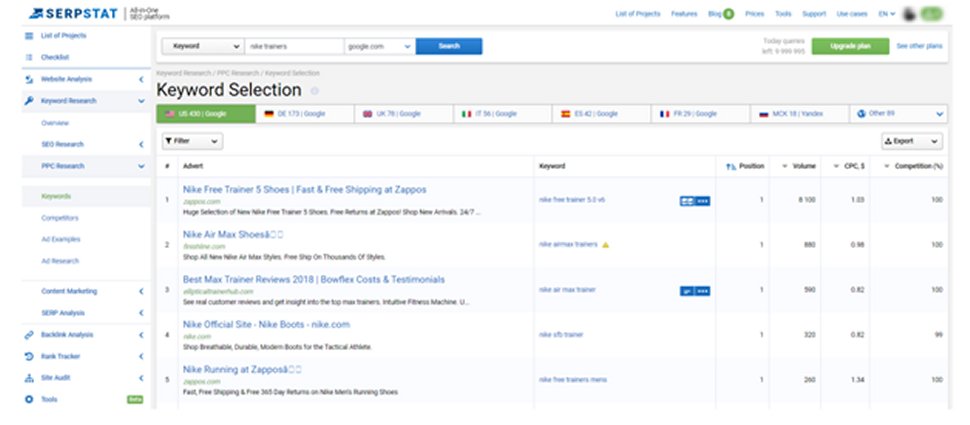
For the breadth of analytics capabilities that Serpstat offers, the user interface is impressively friendly. To start, the five modules that makeup Serpstat are neatly organized into a menu on the left-hand side of the dashboard. The menu uses drop-downs to give you access to individual features, but there are never multiple layers of menus to search through. Another thing that was nice about Serpstat’s interface was how it helps you organize your work. You can create not only projects but also checklists to keep track of tasks that need to be done. Serpstat offers checklist templates for common applications like keyword quality control and link optimization, and you can also create your own custom templates for future use.
- We've featured the best rank checking tools.
Serpstat: Support

Support
Serpstat offers tons of resources for its users like the Serpstat Academy, Case Studies, User's Guide, and Video Tutorials. If you’re looking for urgent support, you can reach out to Serpstat’s support team via direct chat, where personnel is available between Monday to Friday from 10:00 AM to 06:00 PM (GMT+2). There is also an advanced onboarding which is available for paid users, where you receive personalized assistance from a dedicated virtual assistant to start your SEO journey with Serpstat. Its premium customers also have the opportunity for one-on-one training sessions via Skype or Hangouts. Moreover, Serpstat’s support team is quite responsive and crisp, which makes sure that their communications are clear and effective.
Serpstat: The competition
Serpstat is an excellent tool for the price. However, it falls a bit short of competitors like SEMRush and Moz Pro when it comes to domain analysis and competitor research. Both of these platforms include data from social media in reporting rather than limiting you to Google search results. In addition, SEMRush has a “Backlink Gap” tool that makes it much easier to find competitive referral opportunities. However, you’ll pay a bit more for plans with either SEMRush or Moz compared to Serpstat.
Serpstat: Final verdict
Serpstat is an impressive SEO tool that is both powerful and easy to use. Its keyword research is extremely detailed and works like a breeze. Plus, it also has an accurate rank tracker that delivers authentic data along with various insights into your competitors. Although it may have some limitations if you’re a beginner who is not experienced with using SEO tools, its wide range of features and affordable price make it a top choice in the SEO tool market.
- We've also featured the best online marketing tools.
Pawan Singh is a tech writer at TechRadar Pro, where he contributes fresh how-to guides, product reviews, and buying guides within the tech industry. Apart from his writing duties, Pawan offers editorial assistance across various projects, ensuring content clarity and impact. Outside the world of tech, he enjoys playing basketball and going on solo trips.
